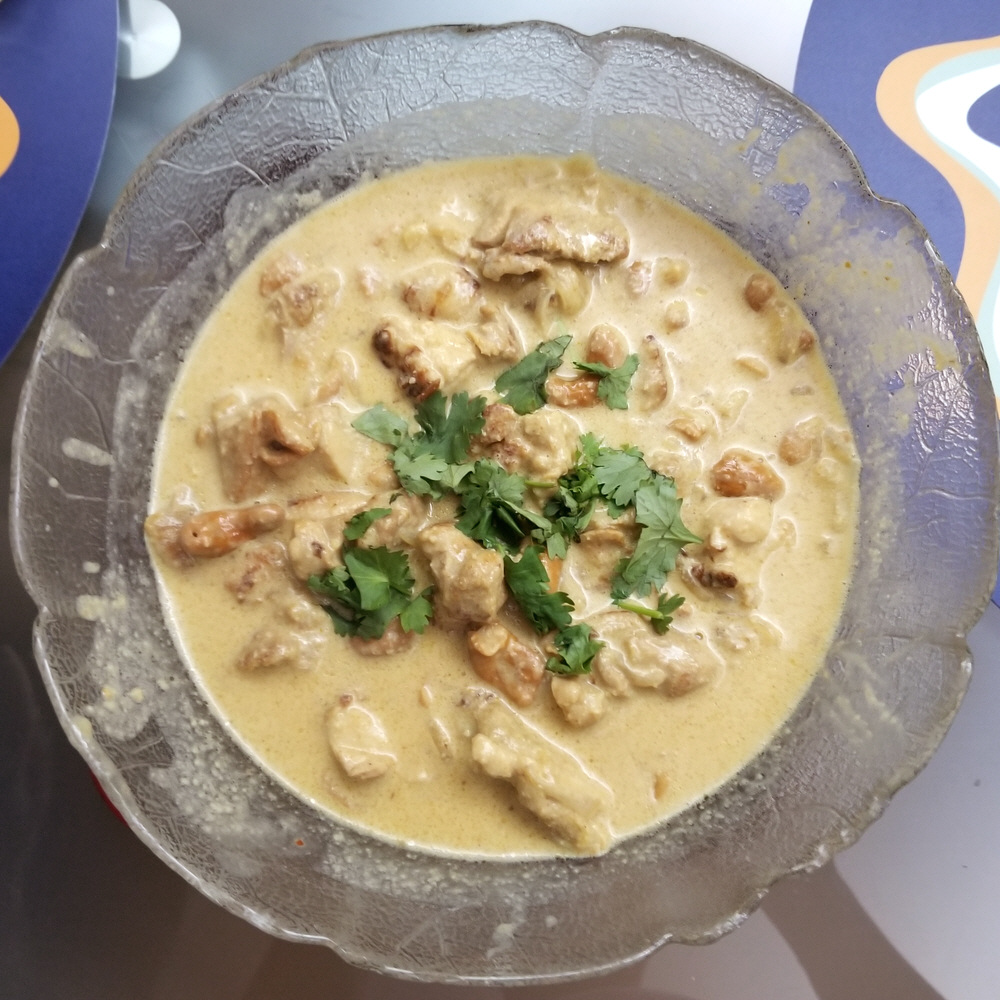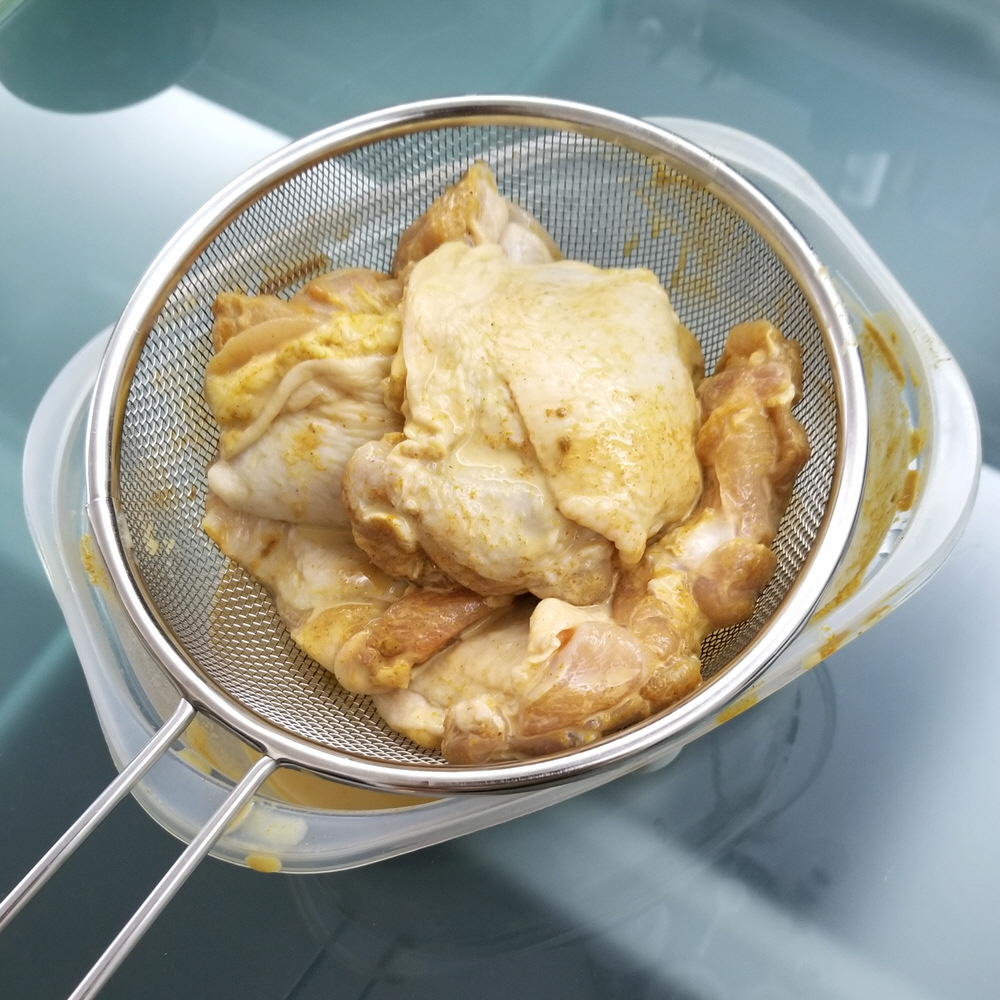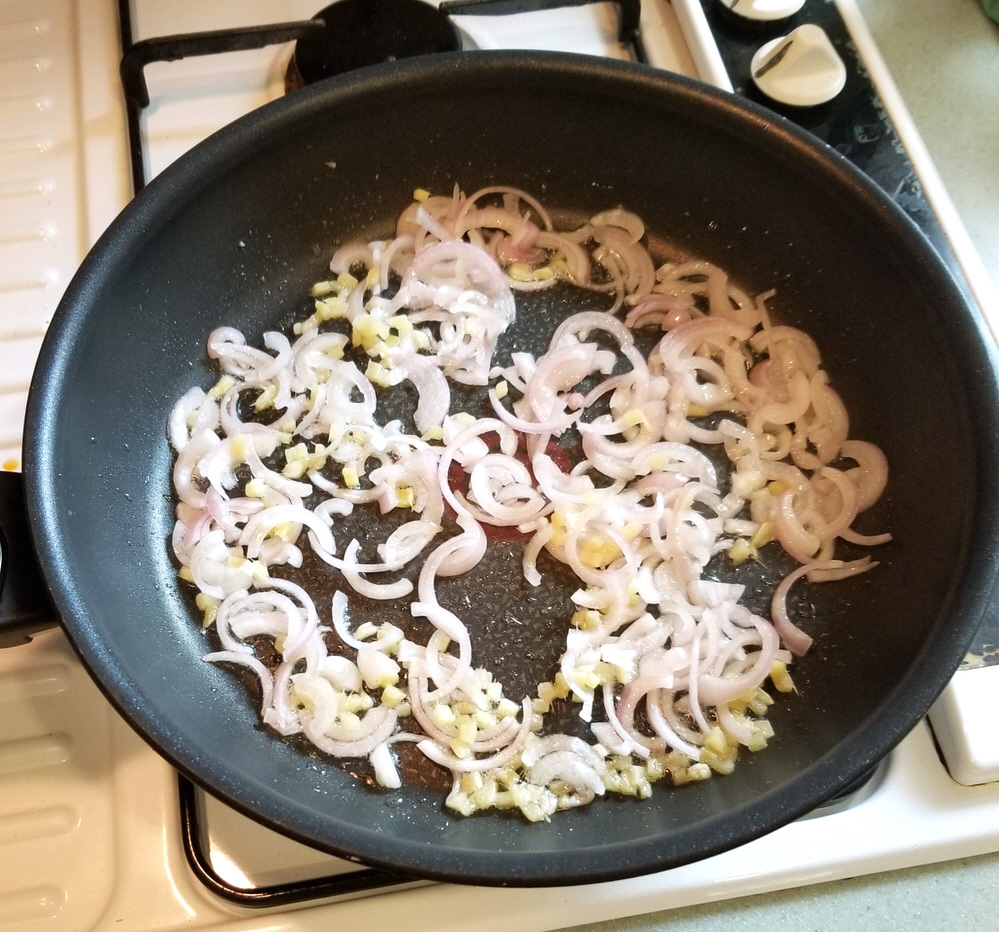(serves 3)
Every place has its own way to prepare Korma but its features are universal. The curry is always cooked using almonds and/or cashew nuts as its base flavour, it is always light couloured and it is always mild. This last characteristic makes Korma the go to curry for anyone who are not into spicy food, and children. The Singapore method uses evaporated milk instead of yogurt or coconut milk to marinate the meat and this creates a distinct texture and taste unique to this method of preparation.
 Ingredients
Ingredients
- Chicken Thighs (4, deboned)
- Shallots (4)
- Ginger (1 thumb)
- Evaporated Milk (100 ml)
- Coconut Milk (150 ml)
- Almond Flour
- Curry Powder
- Cumin
- Chicken Cube (1)
- Cashew Nuts (50g)
Preparation (4-6 hours ahead)
- Place the chicken into a bowl or plastic container and sprinkle in 2 heaped T of curry powder. Evenly coat each piece of chicken. Add 100 ml of evaporated milk, and mix well. Cover and leave in the fridge for a minimum of four hours.


Preparation
- Peel and cut each shallot in half. Julienne the shallots.

- Peel the ginger and cut first into slices 2mm thick. Next slice into strips and then finally cubes.
- Put 3T of oil in a large pan and add the sliced shallots and diced ginger. Pan fry until the shallots start to brown. Transfer the contents to a plate temporarily.
- Dissolve 1 chicken cube in 1 cup of water. Add the resulting chicken stock to the chicken and move the chicken about to wash off the marinade. Drain the chicken in a strainer over the container as shown above.
- Using the same pan, heat up 1 T of oil and pan fry the chicken. Start with a sizzling hot pan and fry the chicken skin side down for 2 minutes. Flip the chicken, turn the heat down and pan fry for a further 2 minutes.
- Transfer the chicken to a cutting board to cool.
- Pour the diluted marinade into the pan and return the shallots and ginger to the pan.

- Bring the pan to a simmer and sprinkle in 4T almond flour and 1T cumin. Stir until there are no clumps and leave on a simmer.
- By now the chicken should have cooled enough to touch. Cut each chicken thigh into about six pieces. Return the chicken together with any drippings back into the pan.
- Add 150 ml coconut milk, 50 g (1/4 cup) of roasted cashew nuts and 1t of sugar. Cover and simmer for an additional 10 minutes.
- Check if you wish to add salt before serving. Chop up 1 sprig of coriander and use it as a garnish.
Notes
- In case you are wondering what is curry powder,
 you can refer to the ingredients listed on the package of curry powder on the right. Curry powder is the base for making curries. It is not the same as Garam Masala, which is just a seasoning.
you can refer to the ingredients listed on the package of curry powder on the right. Curry powder is the base for making curries. It is not the same as Garam Masala, which is just a seasoning.
- If you’ll be making other dishes, you can prepare your korma ahead of time and just reheat to serve. It doesn’t taste any better if freshly made.
- The thicker parts of a chicken thigh will not be cooked from 4 minutes of pan frying, especially without a drop lid. That’s fine, simmering in the curry will finish the job. The idea is to caramelize the chicken and extract the oil and flavour from the skin.
- I find cutting the chicken using a pair of kitchen scissors easier than using a knife.
- Though its not part of the recipe, you should serve your korma with steamed rice or some kind of Indian bread.
Tags: Almonds, Cashews, Chicken, Coconut, Curry, Shallots
(serves 4)
In winter curry is a really nice hearty food that warms you up. This is a great basic Southern Indian curry recipe suitable for most palates and ideal for those cooking curry for the first time. It is mild in two ways. The grassy flavour of mutton is greatly reduced and so people who don’t like the taste of lamb may find it actually quite nice. It is also not very spicy, so those who don’t fancy spicy foods might still find it acceptable.
Ingredients
- Lamb Belly (500g)
- Potato (2 Large)
- Carrot (1)
- Onion (1)
- Shallots (4)
- Coconut Milk (1 Cup)
- Curry Powder
- Caraway Seeds
- Cumin
- Turmeric
- Vegetable Cube
Preparation
- Cut the lamb into one inch cubes. Trim off any obvious large layers of fat. It’s easiest to do this when the meat is semi-frozen, but warm to room temperature using water before proceeding with the next step.
- Place the lamb pieces in a pot and pour in boiling water from a kettle until the water level is a inch above the meat. Stir, wait 5 minutes, and pour the water away.
- Take the meat out of the pot and dry the pot over the stove.
- Peel and julienne 4 shallots. Using a low flame, pan fry the shallot slices in 4T of oil.

- When the shallot begins to brown add 4T Curry Powder and 2T Cumin to the pot and stir fry. Add water a bit at a time until you end up with a watery paste.
- Add 5 cups of water. When this comes to a boil, add the lamb belly pieces followed by 1t turmeric, 1t caraway seeds, 1 vegetable cube, 2t sugar and 2t salt.
- Cover the pot and keep it on a low simmer for 45 minutes.
- In the meanwhile, peel and cut the carrots into half inch thick discs and the onion into twelve wedges. Peel and cut each potato in 4. Dice one of the quarters into tiny cubes (you want them to disintegrate).
- After the 45 minutes is up, add the vegetables and 1 cup of coconut milk and simmer for a further 30 minutes. Boil uncovered and use this period to manage the thickness of curry to what you prefer.
- This curry can be prepared ahead of time and reheated for serving. Depending on the curry powder you may need to add more salt. Remember to taste before serving.
Notes
- Your curry is ideally served with rice, which you will also have to cook. A long grained rice is ideal, like Indian Basmati or Thai Jasmine rice. Any kind of sturdy bread, like Paratha, Naan, or even French Baguette would be an alternative staple.
- In case you are wondering what kind of curry powder to buy, you can refer to the contents of the curry powder I use pictured above. Once you examine what curry powder is made of, you’ll realize that the addition of 2T of cumin in the recipe serves to dilute the overall amount of chili, thus making the curry less spicy.
- The coconut milk also makes the curry less spicy, so if you want a more spicy curry, use only half a cup of coconut milk.
- If you are the type who wants the full flavour of lamb, skip step 2 whose purpose is to reduce the grassy overtones of the lamb. You can also use a lamb stock cube instead of a vegetable stock cube. As for myself, I usually use 1T of red miso in place of the vegetable cube. This really enhances the taste of the whole dish.
- This recipe can easily adapted to make chicken curry. Leave out the caraway seeds and use a chicken cube instead. Chicken doesn’t need to be cooked for that long so skip the entire 45 minute simmer and add the chicken pieces together with the vegetables in step 9.
- If you want a more northern taste to your curry, use plain yogurt in place of coconut milk and cherry tomatoes in place of the carrots.
Tags: Coconut, Cumin, Curry, Lamb, Onion, potato, Rice
(serves 8)
Otak-otak is a terrine-like grilled fish delicacy from South-east Asia, an exotic spicy dish that works as a western appetizer. There are many varieties of Otak-otak from Thailand all the way down to Indonesia; this version is of the Straits Chinese style featuring coconut milk, popular in Singapore and Penang. Otak-otak is usually grilled in banana leaves and contains other ingredients uncommon in the Western kitchen, but I have worked out a modified recipe that resolves these issues.
Ingredients
- White Fish Fillets (500g)
- Yeo’s Minced Prawns in Spices (2x160g tins)
- Coconut Milk (160 ml)
- Onion (0.5)
- Egg (1)
- White Sandwich Bread
- Lemon
- Cucumber
- Sherry
- Lemongrass
- Tarragon
Preparation
- Dice half an onion and pan fry the pieces on low heat in a pan with a dash of oil. When the onion begins to get limp turn up the heat and add the two cans of minced prawn to the pan and continue frying until you see bubbling. Sprinkle on 2t lemongrass and 1t tarragon and transfer the contents of the pan to a large mixing bowl when it has cooled down.
- Make a brine out of 1T salt, 1t sugar, 1T of lemon juice and 2 cups of water. Cut the fish into chunks and put them in the brine them for 20 minutes (and no more). Rinse and place the fish pieces on a tea towel to dry. You can do this concurrently with step 1.
- Cut 2 slices of plain bread into small cubes. If the bread is fresh and the crust is still soft you can keep the crust, otherwise trim the crust off. Pour in 160 ml of coconut milk over the diced bread followed by 1 egg, 1T of sherry and 1t of sugar. Mix well, then add the fish.
- Place a quarter of the fish and bread mixture in a food processor and give it a 2 second pulse (and no more) on low power. Transfer the resulting fish paste to the mixing bowl with the shrimp and onion. You want the fish paste to be coarse but even, so you cannot blend too much at a time. Repeat another three times to use up all the fish and bread. Stir everything in the mixing bowl until you get an even colour.
- Preheat your oven to 150oC (300oF).
- Pour the seafood mixture into a medium sized casserole dish. The casserole dish should be big enough such that the thickness of the seafood is no more than one inch. Cover the casserole dish, if it doesn’t have a cover you can use aluminium foil snugly crimped over the top.

- Place the casserole in the oven. The idea is not so much to bake the fish but to steam it. After 40 minutes, remove from the oven and allow to cool. There will be bulge in the centre initially but this will flatten over time. What you have now is a seafood terrine of sorts.
- When the terrine is cold, and this can be several hours later or even overnight (in the fridge), put it back in the oven, this time uncovered, for twenty minutes at 200oC (390oF). This will boil off most of the free liquid, refine the aroma and give the Otak-otak a nice crust – as shown here.
- While still hot, cut the Otak-otak into slices and serve on untoasted plain white bread with some thin cucumber slices.
Notes

Yeo’s Minced Prawns in Spices
- As the fish is cooked for an extended time, there is no point in using fresh fish. I typically use frozen pangasius fillets myself , they are cheap and readily available, but really any kind of white fish is fine. The important thing is to dry the fish (draining on a colander is insufficient) properly after brining as the Otak will end up too wet if you don’t.
- Yeo’s Minced Prawn in Spices a.k.a. Prawn Sambal is a key ingredient that contains in a single tin every ingredient you need for cooking Otak you won’t find in your kitchen larder. Last time I checked, you can order it from Amazon. Its not the perfect solution, but its better than looking for weird ingredients like candlenut and galangal.
- If you don’t like your food spicy, you can use just one tin of the minced prawn instead of two (the child’s version I call this), but you’ll need to add salt and sugar to compensate.
- To bring your Otak-otak to the next level, you can add chunks of whole seafood. For example you could brine a few scallops along with the fish, dice them and add them in step 6. Canned or bottled clams would work well also. If you bake cakes and have pandan essence around, a few drops will also do wonders.
- Instead of on bread, you can also serve Otak-otak with some white rice cooked with coconut milk.
- The Thai version of Otak-otak has a different name, which is Hor Mok Pla.
Tags: bread, Chili, Coconut, Fish, Prawn, Seafood, Singapore Cuisine
 Ingredients
Ingredients 



 you can refer to the ingredients listed on the package of curry powder on the right. Curry powder is the base for making curries. It is not the same as Garam Masala, which is just a seasoning.
you can refer to the ingredients listed on the package of curry powder on the right. Curry powder is the base for making curries. It is not the same as Garam Masala, which is just a seasoning.




